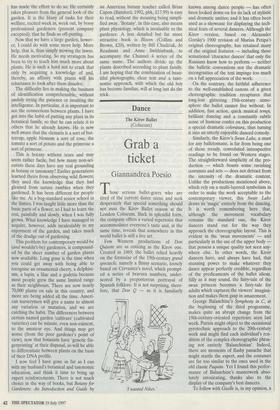Dance
Grab a ticket
Giannandrea Poesio
Those serious ballet-goers who are tired of the current dance scene and seek desperately that special something should not miss the Kirov Ballet season at the London Coliseum. Back in splendid form, the company offers a varied repertoire that accommodates everyone's taste and, at the same time, reveals that somewhere in this world ballet is still a live art.
Few Western productions of Don Quixote are as enticing as the Kirov one. Created in 1869, the ballet relied heavily on the formulae of the 19th-century grand spectacle, namely a flimsy scenario, loosely based on Cervantes's novel, which prompt- ed a series of bravura numbers, under- scored by a preposterous portrayal of Spanish folklore. It is not surprising, there- fore, that Don Q — as it is familiarly I wanted Nikes.' known among dance people — has often been looked down on for its lack of stylistic and dramatic unities; and it has often been used as a showcase for displaying the tech- nical feats of several dancers. Although the Kirov version, based on Alexander Gorsky's 1900 revision of Marius Petipa's original choreography, has retained many of the original features — including those sensational 'character dances' that only the Russians know how to perform — neither the balletic conventions nor the dramatic incongruities of the text impinge too much on a full appreciation of the work.
On the contrary, the faithful adherence to the well-established canons of a given choreographic tradition recaptures that long-lost glittering 19th-century atmo- sphere the ballet cannot live without. In addition, fast action, quick musical tempi, brilliant dancing and a constantly subtle sense of humour confer on this production a special dramatic coloratura, thus turning it into an utterly enjoyable danced comedy.
Similarly, the Kirov's Swan Lake, a must for any balletomane, is far from being one of those trendy, convoluted introspective readings to be found on Western stages. The straightforward simplicity of the pro- duction — which boasts some ravishing costumes and sets — does not detract from the intensity of the dramatic content. Unlike the productions mentioned above, which rely on a multi-layered symbolism in order to make the work acceptable to the contemporary viewer, this Swan Lake draws its 'magic' entirely from the dancing. It is worth remembering here that, although the movement vocabulary remains the standard one, the Kirov dancers stand out for the way they approach the choreographic layout. This is evident in the 'swan movements' — and particularly in the use of the upper body that possess a unique quality not seen any- where else. In other words, the Kirov dancers have, and always have had, that stunning power to make whatever they dance appear perfectly credible, regardless of the predicaments of the ballet idiom. Silly as it may sound, the fairy-tale of the swan princess becomes a fairy-tale for adults which captures the viewers' imagina- tion and makes them gasp in amazement.
George Balanchine's Symphony in C, at the beginning of the third programme, makes quite an abrupt change from the 19th-century-oriented repertoire seen last week. Purists might object to the occasional pyrotechnic approach to the 20th-century work and might find each individual's ren- dition of the complex choreographic phras- ing not entirely Salanchinian'. Indeed, there are moments of flashy panache that might startle the expert, and the costumes are far too similar to the ones used in the old classic Paquita . Yet I found this perfor- mance of Balanchine's masterwork abso- lutely intoxicating, thanks also to the display of the company's best dancers. To follow with Giselle is, in my opinion, a mistake, for the dazzling quality of the first piece thwarted the refined softness of the Romantic work. Giselle, in fact, is a com- plete work, both in dramatic and choreo- graphic terms, that cannot be easily associated with anything else. Pity, for the production looks rather interesting.
As I have already said, the company is in splendid form and boasts a roster of unique artists. Apart from Igor Zelensky and Alty- nay Asylmuratova, who are known to audi- ences here for they make frequent star appearances with British companies, Uliana Lopatkina and Diana Vishneva are the two revelations of this season. Beauti- fully slender and mysterious, the former gave one of the best interpretations of the swan princess I have ever seen. The way she conveys the transformation from a supernatural creature into a human being at the end of the ballet is a true coup de theatre. Vishneva, on the other hand, is a flamboyant artist endowed with an amazing technique and an unparalleled stylistic ver- satility. If you want to know what the magic of dance really is go and grab a ticket. You will not regret it.



























































 Previous page
Previous page